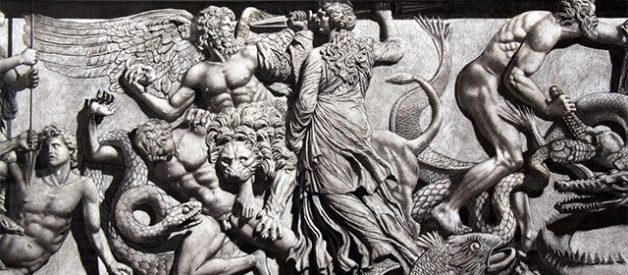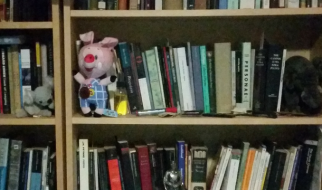For the past six months I have been on a binge of articles and Facebook videos from various channels affiliated with the upcoming Pyeongchang 2018 and Tokyo 2020 Olympic games. Despite getting little tidbits of knowledge of the upcoming games, I realized much of the history of the games eludes me. I?m sure for most fans of the games, they find themselves in similar situations. For most fans, the extent of their knowledge of the games is often limited to certain events of certain years. For myself the only real knowledge I had prior of the history was from readings from various points in my education that would often reference the games but not really dive into the details.
You probably learned that the games originated in the Olympiad in Greece. You may have heard that the only event in the original games was the foot race. You definitely remember that the events were often done in the nude. Butts on butts? hot. If you want to find out a more however then take a little time from you oh so busy day to give my article a little read.
The first Olympics is dated back to 776 BCE and took place in the small sanctuary of Olympiad. This small safe haven resides in the Olympus Mt. Range between the towns of Elis and Pisa. A site of religious importance from a very early age within the Mycenae civilization, would become a very important political site for the following Greek civilization. The games were means to worship the king of the gods, Zeus. Developing over hundreds of years gaining symbolic importance of Greek culture.
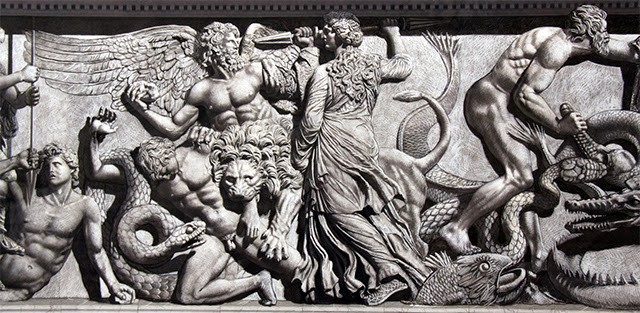 Battle between the Gods and Titans in Greek Mythology.
Battle between the Gods and Titans in Greek Mythology.
There are a few origin stories in Greek mythology of how the games came into existence. The most common and the oldest myth is that of Idaio?s Daktylos Herakles. Zeus, often considered the most important of the Greek gods was said to have battled his titan father Kronos. This was done in attempt to free his brothers and sisters who had been consumed by their father Kronos in fear of being ultimately killed by his offspring. Zeus would free his siblings and the gods were said to settle atop Mount Olympus to wage their war against Kronos and his fellow Titans.
Herakles, a demi-god and leader of the Dactyl would later establish the Olympic games in the name of his father Zeus. Zeus was said to help his son conquer Elis from rival Augeas. As a thank you to the gods, the games were established.
Format of the Ancient Olympic Games
The Olympic games were actually a series of a greater set of athletic competitions. These were called the Panhellenic games. The other three games were the Pynthian games held in Delphi. The Nemean games held in Nemea and Corinthia. Finally there was the Isthmian games held in Isthmia and Sicyon. Like the Olympic games, these were all done in the name of various gods including Apollo, Heracles, Posiedon and of course Zeus. Despite this the Olympic games were still considered the most important of these games. The Nemean Games and Isthmian Games would be held every two years while the Olympic and Pythian games would be every four.
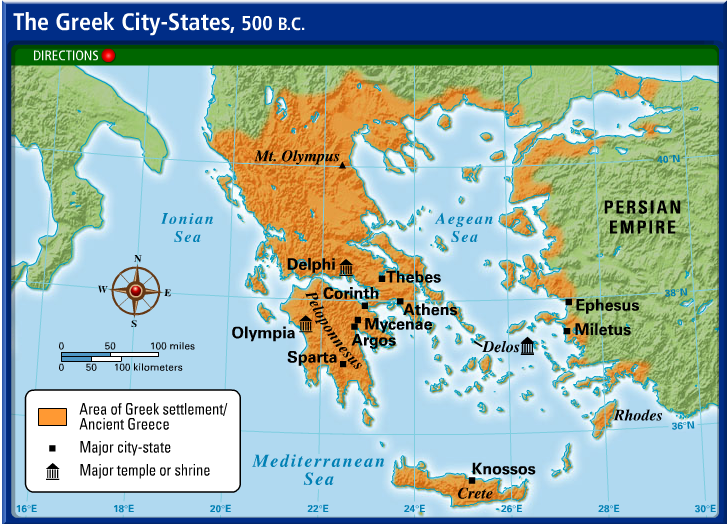 Map of early City-States.
Map of early City-States.
As the power in ancient Greece became centered around city-states in 8th century BC, many of the procedures and rules of the games would come to reflect this. For the first couple hundred years the games were dominated by Peloponnesian athletes. It was much more of a regional religious event at the beginning. These city states often competed in a friendly manner. It wasn?t until the spread of Greek colonies in 5th and 6th century that you see the games elevate to the level of a national event. With this elevation of symbolic importance among the Greek citizens, the games would drift from this friendly, fun loving nature.
The games were a time of a national truce or ?ekecheiria?. The starting of this peace period was represented by three runners know as spondophorio, departing from Elis to each participating city state. This peace period was even supposedly held during times of all out war, including the Peloponnesian War. The truce was eventually broken in 364 BC, but not by any specific city state. The previous organizers of the games, had lost their privilege of hosting the games due to themselves becoming too political. Accused of corruption and duties replaced, they decided to openly attack the new organizers. This was somewhat of an anomaly as most of the time the peace was held. During the Peloponnesian war the games were used as a tool to announce alliances and have large scale sacrifices to the gods.
The contestants of the games could be any free man of Greece. The contestants ranged from kings to shepard to philosophers. However as time went on and the importance of the games increased, many of the contestants would be of either professional athlete or a member of the military. As many of the games were based off of military practices or combat sports this makes sense.
The Olympic games were by no means an example of equality. Women were not allowed to partake in the games and married women were not even allowed to watch the Olympic games. This isn?t to say women athletes were not admired in ancient Greece. Instead women would compete in the Herian games which was devoted to the goddess Heraia.
The events at the games were referred to as gymnikos agon. The translation being nude competition. So yes the games were in fact done in the nude for the most part. The reason seems to be for simply the admiration of the human body. There are other explanations however saying the Spartans long standing tradition of nudity impacted this, aswell as a story of the first Olympic victor losing his pants during the race. Neither of these can be said to be the actual reason but speculation can be made. Males who didn?t participate naked would wear a kynodesme (?dog leash?. Essentially a thong made from a piece of leather, used to restrain a male competitors junk.
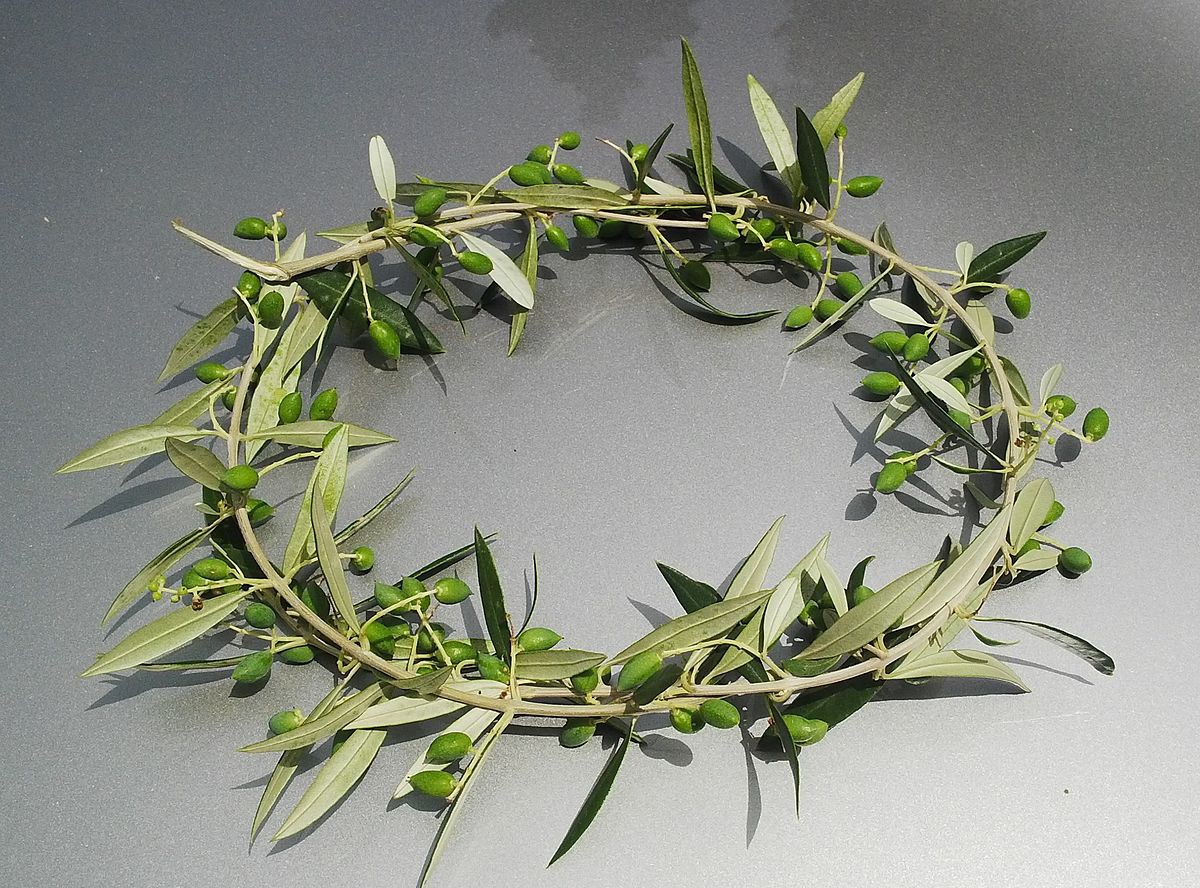 Wreath Made of Olive Leaves
Wreath Made of Olive Leaves
Unlike the modern day games, there was no first, second or third place. It was a winner takes all format. The winner of the event would be presented with a wreath made of wild olive leaves from a tree near the temple of Zeus. However the true prize for Olympic victors was having their name forever immortalized in the list of previous Olympic victors. These records can still be found today.
Location: Mount Olympus
The Olympia sanctuary is positioned in a valley between the Alpheios and Kladeos rivers in the western Peloponnese. The site may also be referred to as Altis. There are traces of inhabitants in the area dating back to 1900?1600 BCE. In the early times, the most important place of worship was Kronion Hill that took up much of the northern side of the sanctuary. As the name suggests, the site was dedicated to the worship of the Titan Kronos, Zeus?s father. This was not the first site of worship within the sanctuary however. The earliest site was actually dedicated to the goddess Gaia and her daughter Themis in Gaion. By the classical era (5th and 4th century BCE), the sanctuary was dedicated solely to Zeus.
Here are two images to help you get the location within Greece and a layout of the layout of the sanctuary.
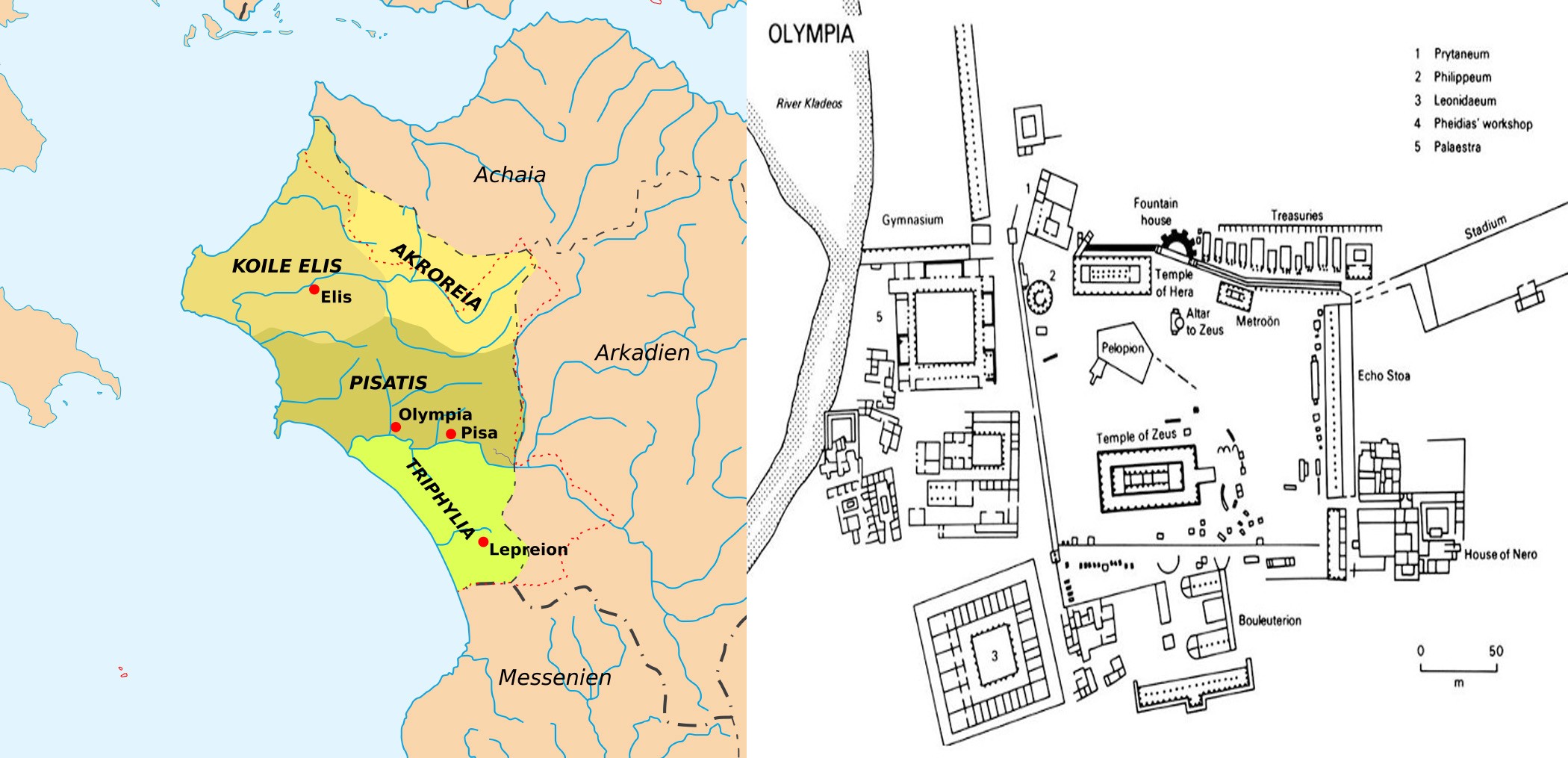
Not only a site of Mt.Olympus, the highest mountain in Greece at 2,918 meters, the sanctuary also was the location of some architectural marvels of the ancient world. As the games became more prosperous due to the spread of Greek colonies and the wealth of city states, more and more resources were put into the site. The most famous buildings being the Doric column temple that you may recognize or at least find familiar. The biggest temple in Greece when constructed would house a massive statue of Zeus. Completed in 457 BCE, designed by the architect Libon of Elis. His work would inspire similar structures, such as the Parthenon in Athens twenty years later. This classical Greek Doric style would take modern architecture interpretations in such buildings as The Lincoln Memorial.
 Illustration of the outside of Temple of Zeus.
Illustration of the outside of Temple of Zeus.
The Ancient Olympic Stadium which early on was located by Mt.Kronion would eventually be moved to just outside of the temple of Zeus. The stadium and sanctuary were connected through a vaulted passageway. The stadium measures about 30 meters wide and over 200 meters long. It is estimated that the stadium could seat nearly 20,000 spectators in seats made of mud. The stadium was also used for the Heraia games for female athletes.
Events of the Games
The first Olympic games only had one event which was a footrace. The games would come to include over twenty three games, however no more than twenty were held at any given Olympics. Many of the events that would come to be a part of the early games were based off of military practices. The ancient Greeks also praised individual sports over team sports. This could be due to the importance placed on individualism in texts such as Homers The Odyssey. From archery, horseback riding and wrestling, to the Hopolite race and pankration. Lets take a look at some of these events in more detail.
Wrestling
Wrestling or Pale would be the first event added to the Olympic games that wasn?t a footrace. Introduced in the 18th Olympiad (708 BCE), wrestling was held in high regards for it?s display of strength, balance and flexibility. These contests were point based, which were rewarded to the participants able to score a fall on their opponent. A fall was classified as the touching of the back to the ground. Unlike modern GrekcoRoman style, the legs played a much more significant role with many more trips and hip tosses in play. Their were other ways to receive points, with such moves as locks and chokes that force submission upon your opponent. For instance being able to apply a rear naked choke with your opponents stomach stretched along the floor would be accepted. So think of a mashup of several styles of modern day combat sports. Elements of Judo, Grekco-Roman and Brazilian Ju jiutsu can all be found.
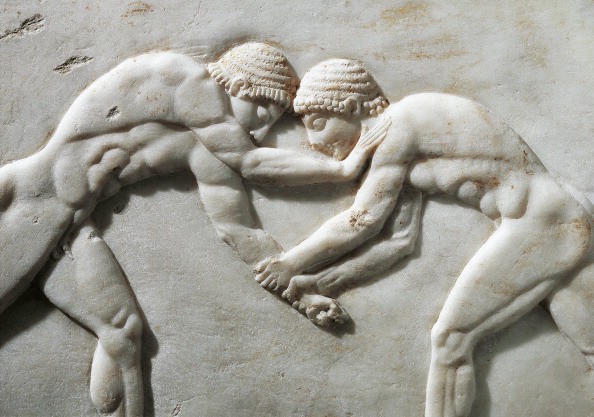
A great article by Christopher Miller called Submission Fighting and the Rules of Ancient Greek Wrestling is a great read to explain the sources that are available to modern day historians to dissect the rules. The article, about a thirty seven page read is a great place to start to learn of the Olympic style of wrestling. It cites the plays and poetry of Homer and Aristophanes. It looks into the relation between ancient Olympic wrestling and the younger cousin Turkish Oil wrestling.
A couple other notes are that wrestling was to be done in the nude and lathered in oil. This made it much harder to get a fixed grip on any part of the opponent and often extended matches. Wrestling was also the only combat sport that the Spartans were allowed to participate in. This is due to the notion that one doesn?t concede ones will to their opponent. In Miller?s article he refutes this point as being incorrect as their are instances of submission type moves being allowed. Regardless wrestling was most popular among contestants of combat sports while spectators still tended to favour the more violent counterparts of pankration and boxing.
Pentathalon
The pentathalon, as the name suggests, is a combination of five events. The five events were discus, javelin. jumping. running and wrestling. Introduced in 708 BCE, the pentathlon was a test of the ideal combination of strength, speed, explosion, flexibility and coordination. High endurance was also needed as all five events took place within an afternoon. The long jump, discus-throw and javelin were only found within the pentathalon. The penathalon was less popular than individual combat or running sports both in terms of viewership and contestants. Their was still great admiration of the athletes of the pentathlon.
Aristotle in his famous piece Rhetoric, describes the body of a young man participating in the pentathalon saying, ?a body capable of enduring all efforts either of the racecourse or of bodily strength? This is why the athletes in the pentathlon are most beautiful.?
There are disputes among historians of how the victor was ultimately named for the pentathalon. Some saying an individual had to win three out of five events, which seems rather odd. The other is the best overall performance. If the victor truly had to place first in three different events, it would leave room for many ambiguous outcomes.
Chariot Races
For the Greeks, equestrian skills were incredibly important for a few reasons. For one, cavalry military practices were incredibly important in ancient Greek warfare. The obvious can also be stated that and individual who possessed such skills was often of a higher social stature, and would be the event that royalty would partake in the games the most.
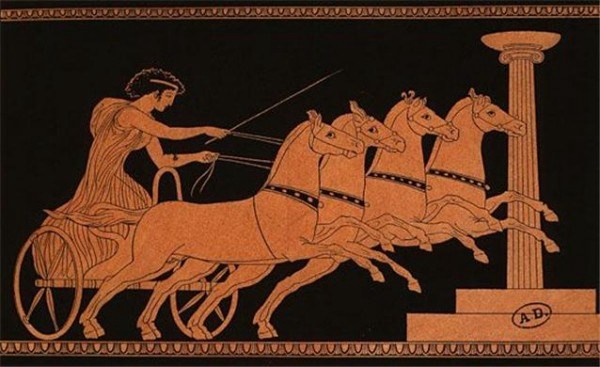 Kyniska of Sparta winning the four horse chariot race.
Kyniska of Sparta winning the four horse chariot race.
The first female Olympic victor won a four horse chariot race in 396 BC. Listed as Kyniska of Sparta, daughter of King Archidamos. Women were actually not allowed to be given the kotinos (victory wreath). A loop whole of sorts however were within the format of the chariot races however. The owner of the horses and chariot rather than the driver were presented the wreath. Kyniska?s position as Spartan royalty obviously was a factor, for the Spartans were often shown some special treatment.
The Stadion
The first Olympic sport ever held was the stadion or stade. The stadion is not only the name of the event but also refers to the distance. The stadion was a six hundred feet foot race and was the only event held for the first thirteen Olympic games. The first Olympic victor was a runner named Koroibos. He was from the city state of Elis and was actually a baker. The prize was an olive branch and having his name etched in olympic records as the first victor ever.
The stadion would eventually branch out into other events such as the double stadion and being included in pentathlon. A long distance version of the stade called the dolichos which ranged between seven and twenty four stades would also The foot races were very popular amongst spectators but behind the combat sports for viewership. However make no mistake, the victors of fleet of foot were held in the highest of prestige amongst atheltes of the games.
End of the Ancient Olympics
So how did the Olympics come to their eventual end. Something that became so entrenched within Ancient Greece politically and religiously? The conquest of the Greek Peninsula from the Romans in 146 BCE following the battle of Corinth really would begin the eventual deterioration of the games. The reason being the deterioration of infrastructure to the to rid Greece?s ?pagan? religion.
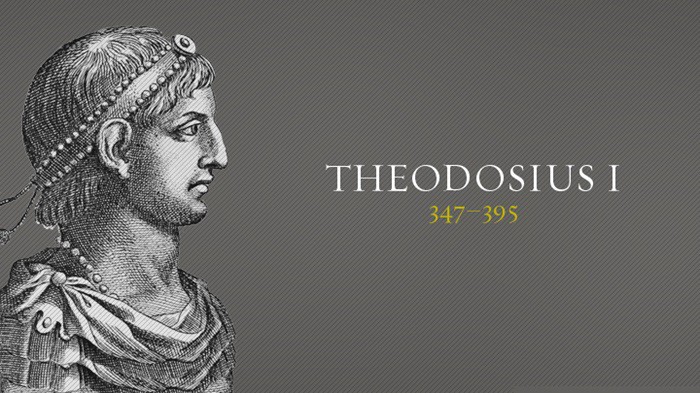
Theodosius I is often the person associated with the direct link to ending of the Ancient Olympic Games. It however cannot be stated Theodosius I literally banned the games. No point within the Theodosian code does it directly state the Olympic Games were to be ended. The code instead was to ban the whole established pagan religion within the Roman state and standardize Christianity. As a result the games would continue as the Olympic Games of Antioch, however strictly as a sporting event rather than a religious festival. These games would proceed until their complete abolition in 520 AD.
The Olympics obviously would not ultimately end there. The International Olympic Committee or commonly referred to as the IOC would begin to bring back the Olympic games towards the end of the 19th century.
Closing Statements and Links
So there you have it, a little dive into some specifics about the Ancient Olympic Games. I hope you learned something as I was able to. If you would like to keep up to date with some Olympic stories or learn about some stories of the past, I will be continuing to create content in hopes of being able to be apart of the 2020 or 2022 games. If you would like some more extensive details on anything I have talked about, I will link some of the articles below.
Reference Links:
https://web.archive.org/web/20160303230834/http://judoinfo.com/research8.pdf
The Fall of the Ancient Olympics: The Theodosian Code
It is a common idea in modern authored histories of the Olympic Games that Theodosius I literally abolished the Olympic?
graecomuse.wordpress.com
Ancient Olympics
Edit description
ancientolympics.arts.kuleuven.be
The Olympic Games of Antioch in the Fourth Century A.D. on JSTOR
The existing studies of these games deal chiefly with their earlier and later history. In the present paper attention?
www.jstor.org
Ancient Stadium in Olympia – Greeka.com
Olympia Ancient Stadium: Information and pictures of the Ancient Stadium in Olympia, Peloponnese, Greece.
www.greeka.com
Olympic Games
The ancient Olympic Games were a sporting event held every four years at the sacred site of Olympia, in the western?
www.ancient.eu
History of Ancient Olympia
Shortly thereafter, the ancient workshop of Pheidias was converted into a Christian basilica. A strong earthquake?
ancient-greece.org
Olympia
Located in the western Peloponnese, Olympia was an ancient Greek sanctuary site dedicated to the worship of Zeus, in?
www.ancient.eu
Ancient Olympic Athletes – Leonidas, Melankomas, Milon
Through the 12 centuries of the Olympic Games, many wonderful athletes competed in the stadium and the hippodrome of?
www.olympic.org
http://www.perseus.tufts.edu/Olympics/running.html
